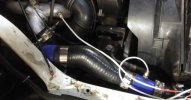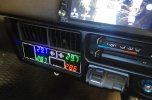No surprises here but yup! I have.
For background I've just cross-posted my Intercooler install thread from Delica.ca here.

K-type thermocouples, one in the inlet manifold, one in the pipe between the turbo and intercooler. Originally they were going to be temporary so I could see how well the intercooler was working, but I've left them in place. More dashboard blinkenlights = more power.
Displays are cheap Aliexpress LED temperature displays. Accuracy was tested by heating the sensors in oil up to 200C while comparing the readings to a known (very) good themometer. Both read about 2deg high, which is close enough for me.

Results: Turbo outlet temperature is usually 50-150C (15psi max) though the sensor is about 50cm downstream of the turbo, and the air has expanded into the 2" pipes from the turbo's 1.5" outlet. I imagine temperature at the turbo is quite a bit higher, but the turbo can handle it.
With good airflow through the intercooler* inlet air temperature is usually 25-50C. When holding full boost on a slow hill IAT tops out around 60C (though this is probably more limited by exhaust temperature: by the time the inlet gets to 60C my EGT is around 1200F, so I'll ease up.)
These numbers seem surprisingly efficient for an intercooler, but I've verified the readings by swapping the sensors over: the numbers are consistent regardless of which gauge I use.
Current exhaust setup:
Ceramic coated side exit, Moroso spiral flow + stainless glasspack resonator.
Boost: 15psi max unless I'm towing, then I limit it to 13psi. Controlled with an HKS EVC controller (the one with the quiet stepper motor rather than the noisy solenoid valve)
Air/Fuel: 20:1 or leaner, tuned/monitored with Innovate Motorsports MTX-L (one of the very few wideband gauges that goes leaner than 19:1).
Tuned as per my FAQ post.
*(ram air from the scoop usually, though there's a fan on the intercooler that comes on if the intercooler core goes above 50C).


